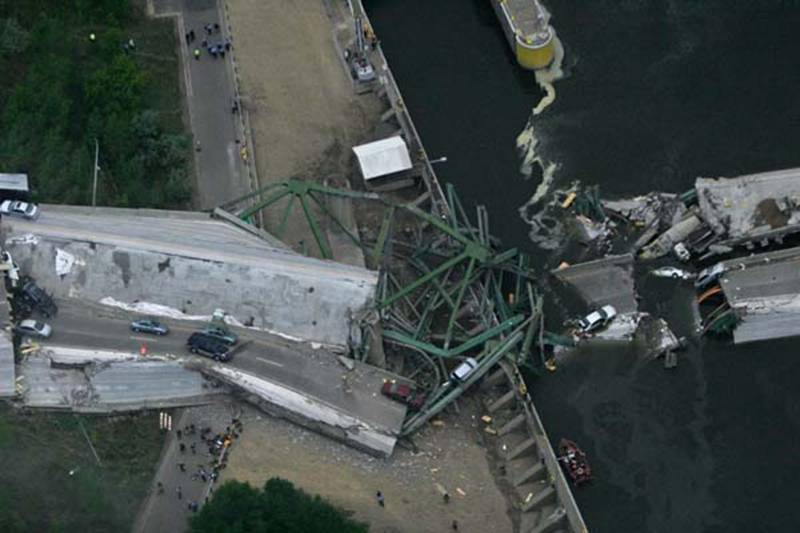The following video (taken from
Wikipedia) was caught by a surveillance camera near the southwest corner of the bridge, overlooking the Lower Saint Anthony Falls Lock.

The following photo of the collapsed bridge is from the windwarriors.net website:

From Wikipedia:
The I-35W Mississippi River bridge (officially known as Bridge 9340) was an eight-lane, steel truss arch bridge that carried Interstate 35W across the Mississippi River in Minneapolis, Minnesota, United States. The bridge is noteworthy because of its catastrophic failure during the evening rush hour on August 1, 2007. It collapsed into the river and onto the riverbanks beneath, killing thirteen people and injuring 145. The bridge was Minnesota's fifth busiest, carrying 140,000 vehicles daily. The NTSB cited a design flaw as the likely cause of the collapse, and asserted that additional weight on the bridge at the time of the collapse contributed to the failure.
---------------------
From the 24-7 News website:
An National Transportation Safety Board (NTSB)investigation into last year’s deadly Minneapolis Bridge collapse has blamed the disaster on gusset plates that were too thin to carry the loads the structure was subjected to. As a result, the I 35 West bridge to collapse under the weight of construction equipment that had been sitting on the structure at the time of the disaster.
Gusset plates act like braces to hold bridge joints together. Deck truss bridges, like the I-35 W Bridge that collapsed, are especially vulnerable if gusset plates fail. That type of bridge design has no back up features to prevent a collapse if one component of the structure fails. For that reason, bridges like the 40-year-old Minneapolis Bridge are rarely built today.
The LA Times is reporting that NTSB investigators told the hearing that the gusset plates on the Minneapolis Bridge did not meet the original design specifications, and were half the thickness required to carry the loads the bridge was subjected to when it collapsed. The gusset plates were also compromised by the weight of infrastructure improvements – including thickening of the driving deck – that had been made on the I 35 W bridge since it opened. Finally, the Minneapolis Bridge was unable to withstand the strain of nearly 300 tons of construction equipment and materials that were piled on the bridge when it collapsed.
According to the LA Times, NTSB investigator Carl Schultheisz said that had the gussets been designed properly, the bridge “would have been able to safely sustain these loads, and the accident would not have occurred.”
---------------------
Although not yet constructed, the nearby Gold Medal Park, which boasts a view of the site of the former and current I-35 bridge, is to be home to bridge collapse memorial. The following information about the future memorial is from the City of Minneapolis website:
Minneapolis Mayor R.T. Rybak and Minnesota Governor Tim Pawlenty announced details of a “Remembrance Garden” that will serve as a memorial to the victims and survivors of the I-35W Bridge collapse, and to the emergency workers and other rescuers who responded to the tragedy. The memorial will be located just west of the bridge in Minneapolis’ Gold Medal Park, where many Minnesotans came together in the hours and days following the collapse.
The Remembrance Garden will feature 13 standing metal beams, each with the name of one of the 13 people killed on Aug. 1, 2007. The beams will encircle a plaza, at the center of which will be a 13-foot wide black granite fountain. The entire memorial will be surrounded by an 81-foot rock square, reflecting the date of the collapse.
The design and location of the Remembrance Garden was developed with input from the families of those who died and bridge collapse survivors. The effort to create the memorial was spearheaded by Dr. William McGuire, whose foundation manages Gold Medal Park, and Tom Oslund, the landscape architect who designed Gold Medal Park.
With the memorial location and design determined, a fundraising effort will be launched to raise at least $1 million to construct and maintain the Remembrance Garden. The Minneapolis Foundation will serve as the fiscal agent, and financial support will be solicited from individuals, foundations, businesses, and others to build the memorial. Those interested in learning more about the I-35W Bridge Remembrance Garden, viewing images of the design, or making a contribution can go to the 35W Remembrance Garden Fund.